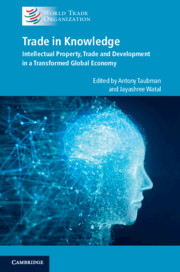Book contents
- Frontmatter
- Contents
- Figures
- Tables
- Contributors
- Preface
- 1 Thematic Overview: Charting the Evolution of Knowledge Flows
- Part I Conceptual Framework
- Part II Measuring Trade in Knowledge
- Part III Impact of Knowledge Flows on Trade and Development
- Part IV Policy, Regulatory and Legislative Frameworks
- Part V Looking Forward
- Index
8 - Sources of Knowledge Flow between Developed and Developing Countries
from Part II - Measuring Trade in Knowledge
Published online by Cambridge University Press: 17 February 2022
- Frontmatter
- Contents
- Figures
- Tables
- Contributors
- Preface
- 1 Thematic Overview: Charting the Evolution of Knowledge Flows
- Part I Conceptual Framework
- Part II Measuring Trade in Knowledge
- Part III Impact of Knowledge Flows on Trade and Development
- Part IV Policy, Regulatory and Legislative Frameworks
- Part V Looking Forward
- Index
Summary
This chapter provides a long-term view on the sources of knowledge flow between developed and developing nations. It relies on patent data to explore three potential sources: R&D collaboration, technology sourcing, and technology transfer. All three sources provide a very consistent message. First, knowledge flows with East Asia, particularly China, are occurring more frequently. Second, knowledge flows are increasingly concentred in information and communication technologies. Third, the United States & Canada had traditionally larger patenting activity with Asia than Europe, but the share of activity between Europe and Asia has been increasing in recent years. Fourth, larger patenting activity between the United States & Canada and Asia implies that the US–Canada region is more likely to benefit from reverse knowledge flows as China progresses towards becoming a technological leader.
- Type
- Chapter
- Information
- Trade in KnowledgeIntellectual Property, Trade and Development in a Transformed Global Economy, pp. 265 - 292Publisher: Cambridge University PressPrint publication year: 2022

